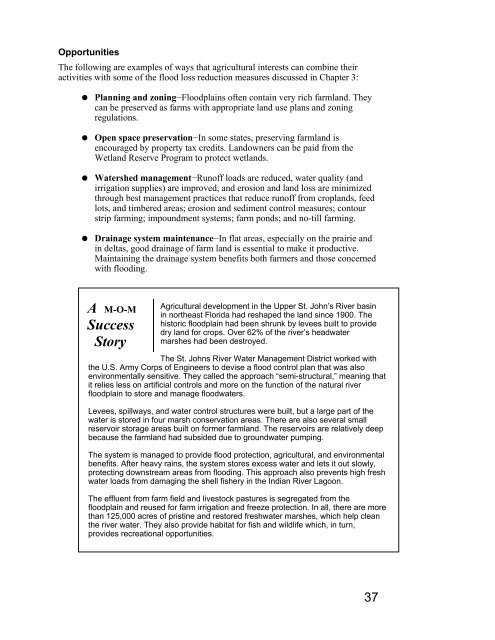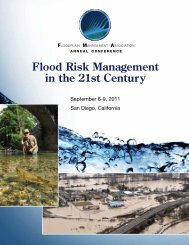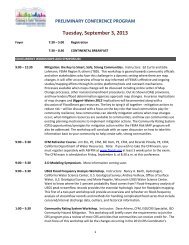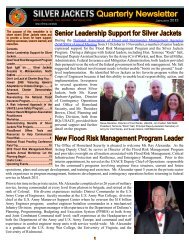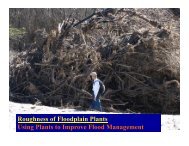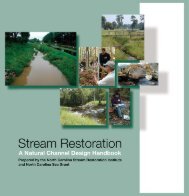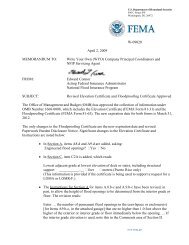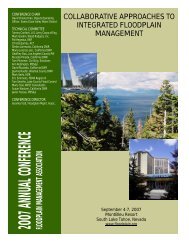Using Multi-Objective Management to Reduce Flood Losses in Your
Using Multi-Objective Management to Reduce Flood Losses in Your
Using Multi-Objective Management to Reduce Flood Losses in Your
Create successful ePaper yourself
Turn your PDF publications into a flip-book with our unique Google optimized e-Paper software.
Opportunities<br />
The follow<strong>in</strong>g are examples of ways that agricultural <strong>in</strong>terests can comb<strong>in</strong>e their<br />
activities with some of the flood loss reduction measures discussed <strong>in</strong> Chapter 3:<br />
Plann<strong>in</strong>g and zon<strong>in</strong>g−<strong>Flood</strong>pla<strong>in</strong>s often conta<strong>in</strong> very rich farmland. They<br />
can be preserved as farms with appropriate land use plans and zon<strong>in</strong>g<br />
regulations.<br />
Open space preservation−In some states, preserv<strong>in</strong>g farmland is<br />
encouraged by property tax credits. Landowners can be paid from the<br />
Wetland Reserve Program <strong>to</strong> protect wetlands.<br />
Watershed management−Runoff loads are reduced, water quality (and<br />
irrigation supplies) are improved, and erosion and land loss are m<strong>in</strong>imized<br />
through best management practices that reduce runoff from croplands, feed<br />
lots, and timbered areas; erosion and sediment control measures; con<strong>to</strong>ur<br />
strip farm<strong>in</strong>g; impoundment systems; farm ponds; and no-till farm<strong>in</strong>g.<br />
Dra<strong>in</strong>age system ma<strong>in</strong>tenance−In flat areas, especially on the prairie and<br />
<strong>in</strong> deltas, good dra<strong>in</strong>age of farm land is essential <strong>to</strong> make it productive.<br />
Ma<strong>in</strong>ta<strong>in</strong><strong>in</strong>g the dra<strong>in</strong>age system benefits both farmers and those concerned<br />
with flood<strong>in</strong>g.<br />
A M-O-M<br />
Success<br />
S<strong>to</strong>ry<br />
Agricultural development <strong>in</strong> the Upper St. John’s River bas<strong>in</strong><br />
<strong>in</strong> northeast Florida had reshaped the land s<strong>in</strong>ce 1900. The<br />
his<strong>to</strong>ric floodpla<strong>in</strong> had been shrunk by levees built <strong>to</strong> provide<br />
dry land for crops. Over 62% of the river’s headwater<br />
marshes had been destroyed.<br />
The St. Johns River Water <strong>Management</strong> District worked with<br />
the U.S. Army Corps of Eng<strong>in</strong>eers <strong>to</strong> devise a flood control plan that was also<br />
environmentally sensitive. They called the approach “semi-structural,” mean<strong>in</strong>g that<br />
it relies less on artificial controls and more on the function of the natural river<br />
floodpla<strong>in</strong> <strong>to</strong> s<strong>to</strong>re and manage floodwaters.<br />
Levees, spillways, and water control structures were built, but a large part of the<br />
water is s<strong>to</strong>red <strong>in</strong> four marsh conservation areas. There are also several small<br />
reservoir s<strong>to</strong>rage areas built on former farmland. The reservoirs are relatively deep<br />
because the farmland had subsided due <strong>to</strong> groundwater pump<strong>in</strong>g.<br />
The system is managed <strong>to</strong> provide flood protection, agricultural, and environmental<br />
benefits. After heavy ra<strong>in</strong>s, the system s<strong>to</strong>res excess water and lets it out slowly,<br />
protect<strong>in</strong>g downstream areas from flood<strong>in</strong>g. This approach also prevents high fresh<br />
water loads from damag<strong>in</strong>g the shell fishery <strong>in</strong> the Indian River Lagoon.<br />
The effluent from farm field and lives<strong>to</strong>ck pastures is segregated from the<br />
floodpla<strong>in</strong> and reused for farm irrigation and freeze protection. In all, there are more<br />
than 125,000 acres of prist<strong>in</strong>e and res<strong>to</strong>red freshwater marshes, which help clean<br />
the river water. They also provide habitat for fish and wildlife which, <strong>in</strong> turn,<br />
provides recreational opportunities.<br />
37


